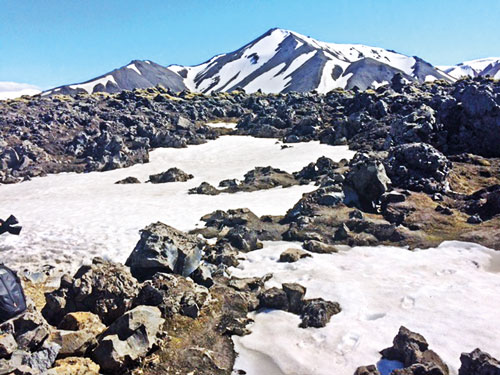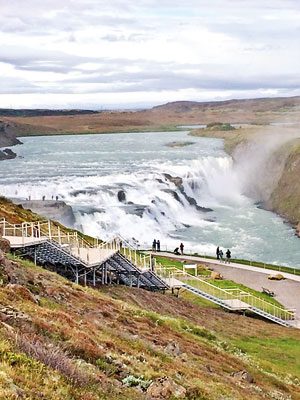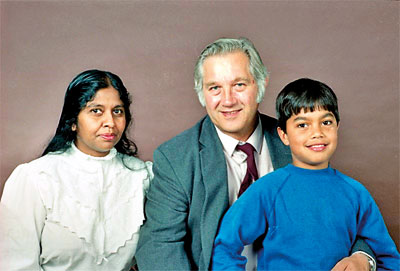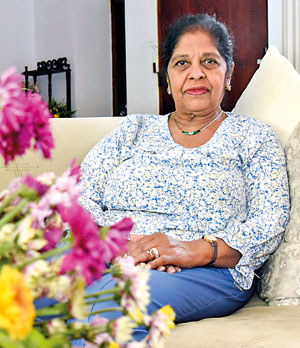Iceland: Where nature’s beauty abounds and place she calls home

Breathtaking views: Rocky mountains and snow
It is ‘the land of fire and ice’, where some of the world’s most active volcanoes seethe above lava fields and some of Europe’s largest glaciers tower and gleam. Iceland is a picturesque home to an abundance of mystical sights and endless vistas of natural beauty with steaming geysers that erupt dramatically, where the peaks of craggy snow-capped mountains reach for the sky and ashy black sand coastlines are lapped by whale-inhabited waters.
For Dr. Aurangasri Hinriksson, the arresting scenery has become a daily sight since calling Iceland home nearly 40 years ago. Born and raised in Sri Lanka, Aurangasri or Auri as she’s more commonly known, made her first visit to the country in 1976 following her marriage to an Icelandic native. The couple made Iceland their permanent residence following the birth of their son in the 1980’s, with Auri going on to teach English, English Literature and Mathematics to students of varying age groups. Auri says that one of the deciding factors for their move to Iceland was so they could educate their son there, Iceland being known for its excellent educational system and having one of the highest rates of literacy in the world.

Gullfoss: One of Iceland’s iconic waterfalls
A resident of Isafjordur, meaning “Ice Fjord” located in the northwest of Iceland, Auri admitted that she knew very little about Iceland prior to her move. “To be honest, I didn’t know anything about Iceland – my mother even thought that Iceland was inhabited by Eskimos, which isn’t true.” Now, Auri has grown accustomed to everything from the climate where temperatures can drop down to a biting -10°C during winter, to the Icelandic language, meticulously preserved for centuries and regarded as one of the most complex languages to learn in the world.
She’s also travelled extensively across the island and lived in areas such as Patreksfjordur in the north-east, rich with untouched nature; Stykkisholmur, a scenic fishing town lined with traditional wooden houses in the west of Iceland; the capital city of Reykjavik; and Höfn, a town located in one of the few natural harbours on Iceland’s south coast. Auri says that the sense of a close-knit community is very evident, with the population in Isafjordur being just over 2700, while Iceland’s entire population numbers just 346,032.
Aside from being considered one of the most popular destinations for tourists, the Nordic nation has also been ranked as one of the “happiest countries in the world” – this in the wake of its post-2007 financial collapse and subsequent revival. Iceland has also consistently been ranked as one of the best places to live in the world owing to its affordable healthcare and education, high degree of gender equality, and low crime rate, among other factors. While the nation’s Coast Guard maintains defences, Iceland does not possess a resident army and police officials do not routinely carry firearms. “Where else in the world can I have my doors open all day long? Where can I have my car open during the day and night? I can do those things where I live,” says Auri.
 Icelandic cuisine includes free-roaming livestock, rich dairy products like the local Skyr – a thick, creamy cheese with the consistency and flavour of yogurt that’s been a part of Icelandic cuisine for over 1000 years, cod, herring, salmon, char, and more that swim in the cold seas. Auri recommends the roast lamb, describing it as a flavourful and exceptionally lean meat from animals raised free of added hormones or steroids. Pesticides and herbicides, she says, are also seldom used in Iceland, where the climate naturally protects the land.
Icelandic cuisine includes free-roaming livestock, rich dairy products like the local Skyr – a thick, creamy cheese with the consistency and flavour of yogurt that’s been a part of Icelandic cuisine for over 1000 years, cod, herring, salmon, char, and more that swim in the cold seas. Auri recommends the roast lamb, describing it as a flavourful and exceptionally lean meat from animals raised free of added hormones or steroids. Pesticides and herbicides, she says, are also seldom used in Iceland, where the climate naturally protects the land.
Other authentic delicacies which she suggests for more adventurous foodies include a shark dish called Hákarl. Hákarl is a Greenland shark that is cured through a fermentation process and hung to dry for four to five months. The traditional Svið or sheep’s head, also falls into this category, with the dish prepared by extracting the brain, singing the outside to remove the fur, and then boiling the head for at least an hour. It is served with mashed potatoes or turnips. Despite the diverse culinary offerings, Auri says that for her, one of the standouts is simply the quality of drinking water in the country. Derived from underground natural springs, green energy and sans polluting industries, Iceland’s water is remarkably pristine.

Dr. Aurangasri Hinriksson in Colombo recently and right, with her family in Iceland in 1987
Auri says that visitors can look forward to attractions like Iceland’s natural hot springs – geothermally heated pools that dot the island. The most popular of these, the Blue Lagoon, just half hour’s drive from Reykjavik is a cerulean oasis famous for its stunning water colour and revitalizing properties. With a unique composition of silica, algae, and minerals, the geothermal combination of seawater and freshwater is reputed to improve certain skin conditions.
The Golden Circle, a 300-kilometre route takes in Iceland’s three most popular natural attractions: Thingvellir National Park, the Geysir geothermal area, and Gullfoss waterfall. The national park alone is steeped in history as the original site of the world’s first legislature and Icelandic parliament, which was formed in 930 AD and remained there until 1798, when it was moved to Reykjavik.
Gullfoss is one of the most powerful and staggering waterfalls in the country, plummeting 105 feet. The spectacle was almost lost during the 20th century due to industrialisation but thanks to the tenacity of the country’s first environmentalist, Sigríður Tómasdóttir, these plans were abandoned and Gullfoss was left in its natural state.
For Auri, the most memorable spectacle she’s witnessed during her time on the island are the nacreous clouds, or the Glitský as it is referred to in Icelandic. The rare phenomenon occurs under specific circumstances when polar stratospheric clouds blaze bright with vivid and shifting iridescent colours.
Perhaps one of the most revered sights in Iceland is the Northern Lights, or Aurora borealis. December is one of the best times to visit the country to view the lights but Auri says that there’s more to enjoy during this time of year in Iceland, notably the uniquely festive atmosphere as locals prepare for the holiday season. “Though the darkest time of the year is December and January, you don’t feel it because of the amount of Christmas lights being put up.” From December 11 until January 6, Iceland celebrates Christmas, during which time the natural beauty of winter is at its most vibrant and locals and visitors alike are guaranteed a white Christmas. On New Year’s Eve, Reykjavik becomes the site of grand fireworks displays that lasts for several hours.
Searching for an ideal partner? Find your soul mate on Hitad.lk, Sri Lanka's favourite marriage proposals page. With Hitad.lk matrimonial advertisements you have access to thousands of ads from potential suitors who are looking for someone just like you.


